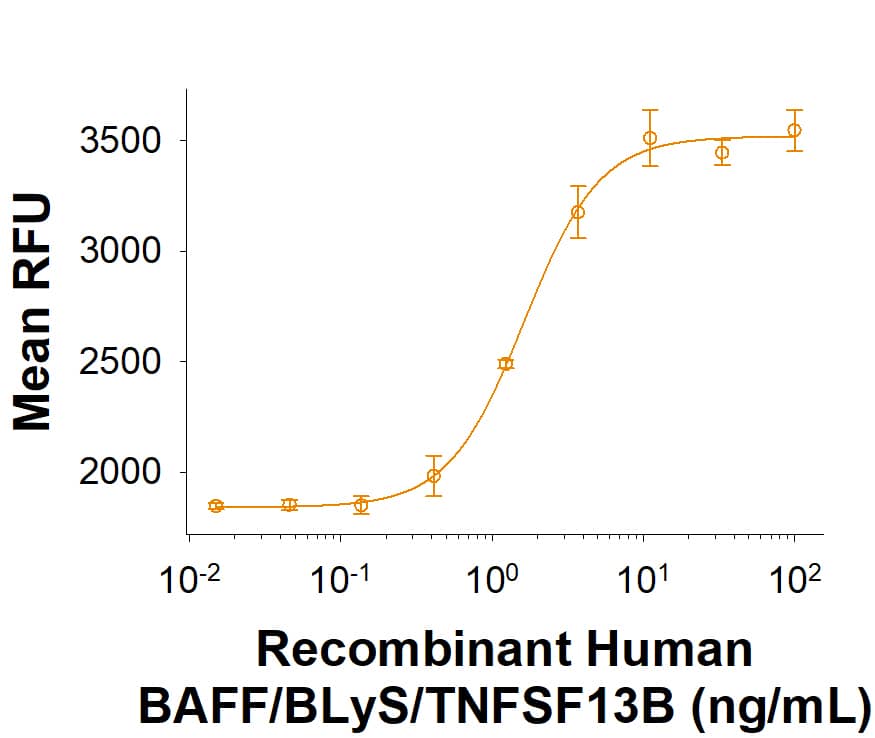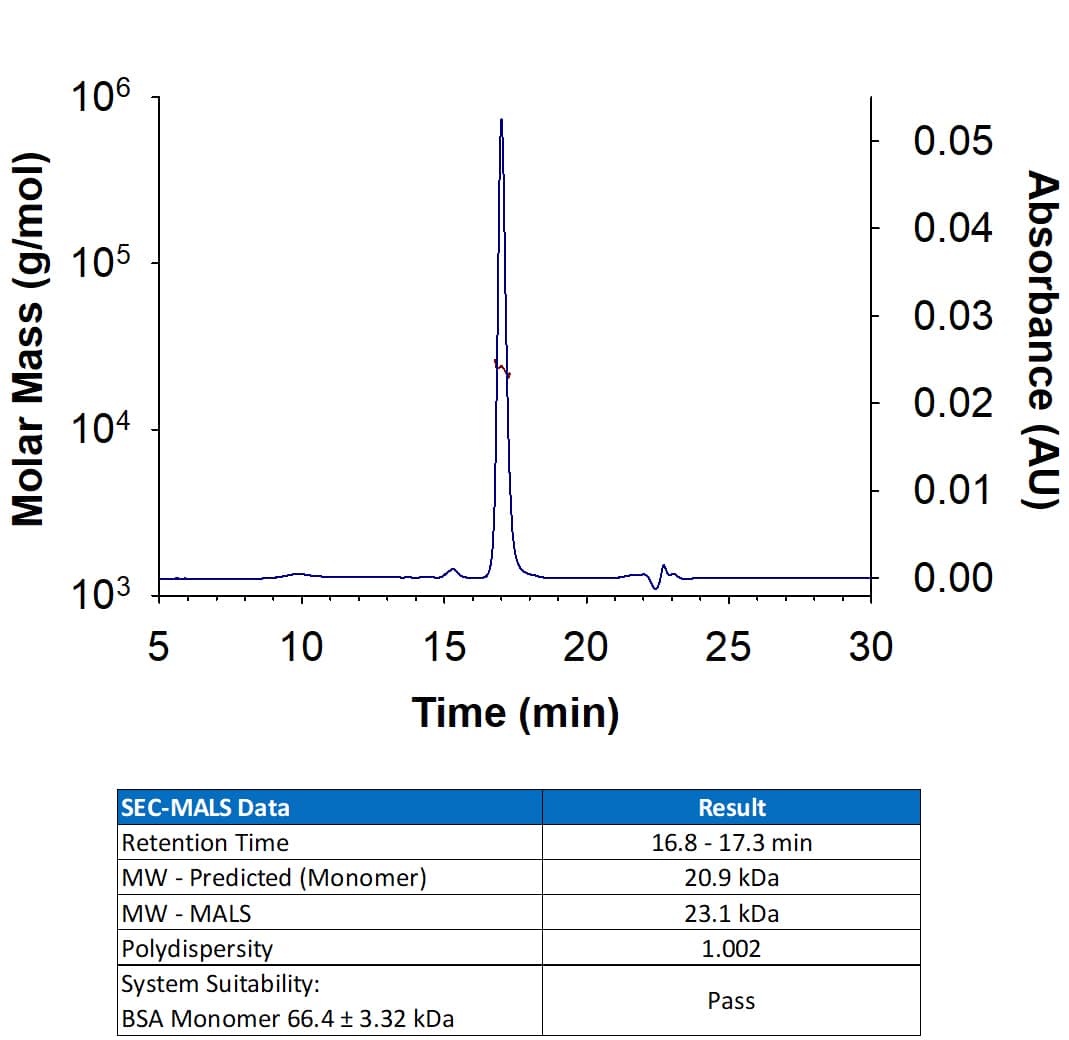Recombinant Human BAFF/BLyS/TNFSF13B Protein Summary
Product Specifications
| MHHHHHHHHHH | GGGSGGGSGGGS | IEGR | Human BAFF (Ala134-Leu285) Accession # Q9Y275.1 |
| N-terminus | C-terminus | ||
Analysis
Customers also Viewed
Product Datasheets
2149-BF/CF (carrier free)
Discontinued Product
2149-BF
| Formulation | Lyophilized from a 0.2 μm filtered solution in PBS, EDTA and DTT with BSA as a carrier protein. |
| Reconstitution | Reconstitute at 100 μg/mL in sterile PBS containing at least 0.1% human or bovine serum albumin. |
| Shipping | The product is shipped at ambient temperature. Upon receipt, store it immediately at the temperature recommended below. |
| Stability & Storage: | Use a manual defrost freezer and avoid repeated freeze-thaw cycles.
|
Background: BAFF/BLyS/TNFSF13B
B-cell activating factor (BAFF), also known as BLyS, TALL-1, THANK, and TNFSF13B, is a 32 kDa transmembrane glycoprotein in the TNF ligand superfamily. It is involved in multiple aspects of immune system regulation, particularly towards B cells (1, 2). Mature human BAFF consists of a 46 amino acid (aa) cytoplasmic domain, a 21 aa transmembrane segment, and a 218 aa extracellular domain (ECD) with a stalk region and one TNF-like domain (3, 4). Within aa 134-285 of the ECD, human BAFF shares 72% aa sequence identity with mouse BAFF. It can be expressed as a homotrimer or as a heteromer in association with the related TNFSF member APRIL (4, 5). A 18 kDa fragment containing the TNF-like domain can be released by proteolysis between Arg133 and Ala134 (4). Soluble BAFF is stored intracellularly in neutrophils and released upon inflammatory stimulation (6). Alternative splicing generates an isoform termed deltaBAFF that lacks 19 aa between the proteolytic cleavage site and the TNF-like domain. deltaBAFF can form heteromers with BAFF and negatively regulates BAFF function (7). BAFF is produced by many hematopoietic cell types including by monocytes, macrophages, neutrophils, dendritic cells, and T cells and also by adipocytes (1, 2, 8). Both BAFF and APRIL are functional ligands for the TNF receptor superfamily members BCMA and TACI, and BAFF additionally binds and signals through BAFF R (9, 10). All three receptors are primarily expressed by B cells (10). BAFF plays a critical role in the development and survival of B lineage cells (2, 11, 12). Mice that overexpress BAFF exhibit elevated B cell numbers, increased formation and size of germinal centers, and symptoms of autoimmunity (13). Soluble BAFF is elevated in B cell malignancies, autoimmunity, and other immune disorders (1). In addition, BAFF co-stimulates T cell activation, promotes a Th1 biased immune response, and promotes the expansion of Treg cells (14-16). BAFF also promotes monocyte survival, proinflammatory cytokine secretion, and differentiation to macrophages (17).
- Lied, G.A. and A. Berstad (2011) Scand. J. Immunol. 73:1.
- Mackay, F. et al. (2010) Immunol. Rev. 237:205.
- Moore, P.A. et al. (1999) Science 285:260.
- Schneider, P. et al. (1999) J. Exp. Med. 189:1747.
- Roschke, V. et al. (2002) J. Immunol. 169:4314.
- Scapini, P. et al. (2003) J. Exp. Med. 197:297.
- Gavin, A.L. et al. (2003) J. Biol. Chem. 278:38220.
- Alexaki, V.-I. et al. (2009) J. Immunol. 183:5948.
- Yu, G. et al. (2000) Nat. Immunol. 1:252.
- Thompson, J.S. et al. (2001) Science 293:2108.
- Schiemann, B. et al. (2001) Science 293:2111.
- Litinskiy, M.B. et al. (2002) Nat. Immunol. 3:822.
- Batten, M. et al. (2000) J. Exp. Med. 192:1453.
- Huard, B. et al. (2001) J. Immunol. 167:6225.
- Sutherland, A.P.R. et al. (2005) J. Immunol. 174:5537.
- Walters, S. et al. (2009) J. Immunol. 182:793.
- Chang, S.K. et al. (2006) Blood 108:2687.
Citations for Recombinant Human BAFF/BLyS/TNFSF13B Protein
R&D Systems personnel manually curate a database that contains references using R&D Systems products. The data collected includes not only links to publications in PubMed, but also provides information about sample types, species, and experimental conditions.
19
Citations: Showing 1 - 10
Filter your results:
Filter by:
-
Regulation of B cell functions by S-nitrosoglutathione in the EAE model
Authors: J Kim, SMT Islam, F Qiao, AK Singh, M Khan, J Won, I Singh
Redox Biology, 2021-06-23;45(0):102053.
Species: Mouse
Sample Types: Whole Cells
Applications: Bioassay -
APRIL and BAFF: novel biomarkers for central nervous system lymphoma
Authors: M Mulazzani, M Huber, S Borchard, S Langer, B Angele, E Schuh, E Meinl, M Dreyling, T Birnbaum, A Straube, U Koedel, L von Baumga
J Hematol Oncol, 2019-10-15;12(1):102.
Species: Human
Sample Types: Whole Cells
Applications: Bioassay -
Condition-dependent generation of aquaporin-4 antibodies from circulating B cells in neuromyelitis optica
Authors: R Wilson, M Makuch, AK Kienzler, J Varley, J Taylor, M Woodhall, J Palace, MI Leite, P Waters, SR Irani
Brain, 2018-04-01;141(4):1063-1074.
Species: Human
Sample Types: Whole Cells
Applications: Bioassay -
An anti-TL1A antibody for the treatment of asthma and inflammatory bowel disease
Authors: AW Clarke, L Poulton, D Shim, D Mabon, D Butt, M Pollard, V Pande, J Husten, J Lyons, C Tian, AG Doyle
MAbs, 2018-03-05;0(0):1-43.
Species: Human
Sample Types: Recombinant Protein
Applications: Surface Plasmon Resonance (SPR -
Abnormal differentiation of B cells and megakaryocytes in Roifman syndrome
Authors: J Heremans, JE Garcia-Per, E Turro, SM Schlenner, I Casteels, R Collin, F de Zegher, D Greene, S Humblet-Ba, S Lesage, P Matthys, CJ Penkett, K Put, K Stirrups, C Thys, C Van Geet, E Van Nieuwe, C Wouters, I Meyts, K Freson, A Liston
J. Allergy Clin. Immunol., 2018-01-31;0(0):.
Species: Human
Sample Types: Whole Cells
Applications: Flow Cytometry -
NF-?B inducing kinase is a therapeutic target for systemic lupus erythematosus
Authors: HD Brightbill, E Suto, N Blaquiere, N Ramamoorth, S Sujatha-Bh, EB Gogol, GM Castanedo, BT Jackson, YC Kwon, S Haller, J Lesch, K Bents, C Everett, PB Kohli, S Linge, L Christian, K Barrett, A Jaochico, LM Berezhkovs, PW Fan, Z Modrusan, K Veliz, MJ Townsend, J DeVoss, AR Johnson, R Godemann, WP Lee, CD Austin, BS McKenzie, JA Hackney, JJ Crawford, ST Staben, MH Alaoui Ism, LC Wu, N Ghilardi
Nat Commun, 2018-01-12;9(1):179.
Species: Human
Sample Types: Whole Cells
Applications: Bioassay -
EZH2 inhibition by tazemetostat results in altered dependency on B-cell activation signaling�in DLBCL
Authors: D Brach, D Johnston-B, A Drew, T Lingaraj, V Motwani, NM Warholic, I Feldman, C Plescia, JJ Smith, RA Copeland, H Keilhack, E Chan-Peneb, SK Knutson, SA Ribich, A Raimondi, MJ Thomenius
Mol. Cancer Ther., 2017-08-23;0(0):.
Species: Human
Sample Types: Whole Cells
Applications: Bioassay -
A TLR9-dependent checkpoint governs B cell responses to DNA-containing antigens
Authors: VJ Sindhava, MA Oropallo, K Moody, M Naradikian, LE Higdon, L Zhou, A Myles, N Green, K Nündel, W Stohl, AM Schmidt, W Cao, S Dorta-Estr, T Kambayashi, A Marshak-Ro, MP Cancro
J. Clin. Invest, 2017-03-27;0(0):.
Species: Human
Sample Types: Whole Cells
Applications: Bioassay -
TACI expression and signaling in chronic lymphocytic leukemia.
Authors: Mamara, Antigoni, Germenis, Anastasi, Kompoti, Maria, Palassopoulou, Maria, Mandala, Eudokia, Banti, Anastasi, Giannakoulas, Nikolaos, Speletas, Matthaio
J Immunol Res, 2015-04-09;2015(0):478753.
Species: Human
Sample Types: Whole Cells
Applications: Bioassay -
Phosphoinositide protein kinase PDPK1 is a crucial cell signaling mediator in multiple myeloma.
Authors: Chinen Y, Kuroda J, Shimura Y, Nagoshi H, Kiyota M, Yamamoto-Sugitani M, Mizutani S, Sakamoto N, Ri M, Kawata E, Kobayashi T, Matsumoto Y, Horiike S, Iida S, Taniwaki M
Cancer Res, 2014-09-30;74(24):7418-29.
Species: Human
Sample Types: Whole Cells
Applications: Bioassay -
Metabolic reprogramming is required for antibody production that is suppressed in anergic but exaggerated in chronically BAFF-exposed B cells.
Authors: Caro-Maldonado, Alfredo, Wang, Ruoning, Nichols, Amanda G, Kuraoka, Masayuki, Milasta, Sandra, Sun, Lillian, Gavin, Amanda L, Abel, E Dale, Kelsoe, Garnett, Green, Douglas, Rathmell, Jeffrey
J Immunol, 2014-03-10;192(8):3626-36.
Species: Human
Sample Types: Whole Cells
Applications: Bioassay -
Diversion of the host humoral response: a novel virulence mechanism of Haemophilus influenzae mediated via outer membrane vesicles.
Authors: Deknuydt F, Nordstrom T, Riesbeck K
J Leukoc Biol, 2014-02-18;95(6):983-91.
Species: Human
Sample Types: Whole Cells
Applications: Bioassay -
H-Y antigen-binding B cells develop in male recipients of female hematopoietic cells and associate with chronic graft vs. host disease.
Authors: Sahaf B, Yang Y, Arai S, Herzenberg L, Herzenberg L, Miklos D
Proc Natl Acad Sci U S A, 2013-02-04;110(8):3005-10.
Species: Human
Sample Types: Whole Cells
Applications: Bioassay -
Overexpression of the autoimmunity-associated phosphatase PTPN22 promotes survival of antigen-stimulated CLL cells by selectively activating AKT.
Blood, 2012-05-08;119(26):6278-87.
Species: Human
Sample Types: Whole Cells
Applications: Bioassay -
BlyS is up-regulated by hypoxia and promotes migration of human breast cancer cells.
Authors: Zhu J, Sun L, Lin S
J. Exp. Clin. Cancer Res., 2012-03-31;31(0):31.
Species: Human
Sample Types: Whole Cells
Applications: Bioassay -
BAFF is increased in renal transplant patients following treatment with alemtuzumab.
Authors: Bloom D, Chang Z, Pauly K
Am. J. Transplant., 2009-06-12;9(8):1835-45.
Species: Human
Sample Types: Whole Cells
Applications: Bioassay -
Neutralizing B-cell activating factor antibody improves survival and inhibits osteoclastogenesis in a severe combined immunodeficient human multiple myeloma model.
Authors: Neri P, Kumar S, Fulciniti MT, Vallet S, Chhetri S, Mukherjee S, Tai Y, Chauhan D, Tassone P, Venuta S, Munshi NC, Hideshima T, Anderson KC, Raje N
Clin. Cancer Res., 2007-10-01;13(19):5903-9.
Species: Human
Sample Types: Whole Cells
Applications: Bioassay -
Decreased expression of tumor necrosis factor family receptors involved in humoral immune responses in preterm neonates.
Authors: Kaur K, Chowdhury S, Greenspan NS, Schreiber JR
Blood, 2007-07-18;110(8):2948-54.
Species: Human
Sample Types: Whole Cells
Applications: Bioassay -
IL-21 and BAFF/BLyS synergize in stimulating plasma cell differentiation from a unique population of human splenic memory B cells.
Authors: Ettinger R, Sims GP, Robbins R, Withers D, Fischer RT, Grammer AC, Kuchen S, Lipsky PE
J. Immunol., 2007-03-01;178(5):2872-82.
Species: Human
Sample Types: Whole Cells
Applications: Bioassay
FAQs
No product specific FAQs exist for this product, however you may
View all Proteins and Enzyme FAQsReviews for Recombinant Human BAFF/BLyS/TNFSF13B Protein
Average Rating: 5 (Based on 3 Reviews)
Have you used Recombinant Human BAFF/BLyS/TNFSF13B Protein?
Submit a review and receive an Amazon gift card.
$25/€18/£15/$25CAN/¥75 Yuan/¥2500 Yen for a review with an image
$10/€7/£6/$10 CAD/¥70 Yuan/¥1110 Yen for a review without an image
Filter by:
Reason for Rating: works in reporter assay














